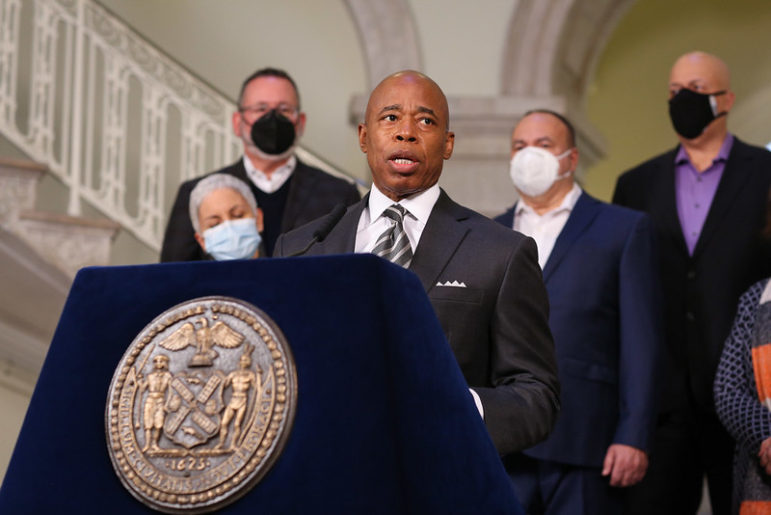‘Thousands of units of supportive housing—affordable housing with onsite support services for people experiencing homelessness who face additional barriers to stability—are standing vacant for months while more than 70,000 New Yorkers remain in shelter and on the streets. This is the ultimate inefficiency.’

Michael Appleton/Mayoral Photography Office
Mayor Eric Adams makes a housing-related announcement at City Hall on Jan 30.We agree with Mayor Eric Adams that the city needs to focus on increasing efficiency, but are concerned that “efficiency” is often a euphemism for staff and budget cuts. In the case of the city agencies that are working to end homelessness, the city should instead intentionally and immediately increase resources in order to achieve the ultimate efficiency: getting people out of shelters, off the street and into permanent housing.
Right now, lack of investment in staff and technology by the previous administration has left the system crippled. Thousands of units of supportive housing—affordable housing with onsite support services for people experiencing homelessness who face additional barriers to stability—are standing vacant for months while more than 70,000 New Yorkers remain in shelter and on the streets. This is the ultimate inefficiency.
 CityViews are readers’ opinions, not those of City Limits. Add your voice today!
CityViews are readers’ opinions, not those of City Limits. Add your voice today!
A fall 2021 survey the Supportive Housing Network conducted with our members reported a 10 percent vacancy rate due to a lack of referrals, with some units remaining vacant for over a year. Extrapolating over the New York City supportive housing portfolio suggests that there are some 2,500 supportive apartments awaiting tenants. Meanwhile there are approximately 8,000 eligible applicants ready to move into those apartments. Instead, those individuals are languishing in shelters or on the streets.
Part of the problem lies in the city’s failure to grow their placement capacity at pace with the number of supportive housing units being developed. We helped advocate for and won historic city and state commitments in 2016. This has led to twice as many supportive apartments coming online last year compared to five years ago. In addition, the placement team is responsible for ‘re-rentals’ as 10 percent of the city’s 25,000 units turns over each year. Yet the team has not grown to meet the added demand.
The pandemic exponentially exacerbated these problems. The already slow and burdensome homelessness-to-housing process suddenly needed to take place virtually. And due to budget constraints, the city imposed hiring freezes which, in turn, led to even more departures as remaining staff coped with increased workloads.
READ MORE: Administrative Obstacles Jam Up Moving Process for NYC Shelter Residents
To achieve true efficiency, the city should focus laser-like on short and long-term solutions. Under the new Department of Social Services (DSS) commissioner’s leadership, the city should quickly assemble a “war room” of nonprofit and government experts to fill at least 2,000 of those 2,500 apartments within the next 100 days. The administration should also immediately lift the hiring freeze and expedite hiring new staff at the Office of Supportive & Affordable Housing & Services within the DSS. In the meantime, additional staff resources need to be deployed from other departments to assist.
Meanwhile, the city needs to invest in the Coordinated Assessment and Placement System (CAPS). This web-based system currently determines client eligibility for various housing options, centralizes data, pulls documents from various systems and recommends housing placement types. If the city invested in building out the system, work that is currently being done manually—confirming vacancies, scheduling interviews and getting people placed—could speed the process exponentially. Hiring freezes in this team, as well as glacial contracting processes, are also slowing progress. In the drive for greater efficiency, this is low hanging fruit.
Long term, the administration should create a think tank that includes government agency partners, nonprofit supportive housing and shelter and outreach providers as well as currently and formerly homeless New Yorkers. This new entity would be tasked with reviewing how individuals access homes and brainstorming how to cut red tape to make the process both more efficient and less traumatizing.
New York City invented supportive housing and has invested in it like no other city in the world. We now need to make it easier and faster for eligible New Yorkers to access. That is the ultimate efficiency.
Laura Mascuch is the executive director of the Supportive Housing Network of New York.









3 thoughts on “Opinion: A Focus on ‘Efficiency’ Will Keep Thousands of New Yorkers Needlessly Homeless”
What is needed is an overhaul of DHS and HRA. More Section 8 Vouchers need to be issued to those who are eligible for them. This is why there is failure of a system that is suppose to help those who need the help.
Ceo Renee Mitchell of Breaking The Cycle Drop Corp said you need wrap around service all on site so you can address the root cause and push them toward self sufficient to make better choices. Each case is different. Bring back cont. Care and bring back inpatient psychiatric beds for unshelter homless with serious mental illness.
My name is Marlene I have been homeless for over 9 years at first I slept in hallways being raped and sexually harass I have been with ICL agency for over8 years now I’m still from shelter to shelter with many physical and health problems and in need of 2 shoulder surjuries for over 8 years can’t get my surjuries until I get my permanent supportive housing so I can get the help I need this system has failed us all that talk is cheap do some thing about already for the major put your money where your mouth is because there hasn’t been no change how many years must we keep suffering.